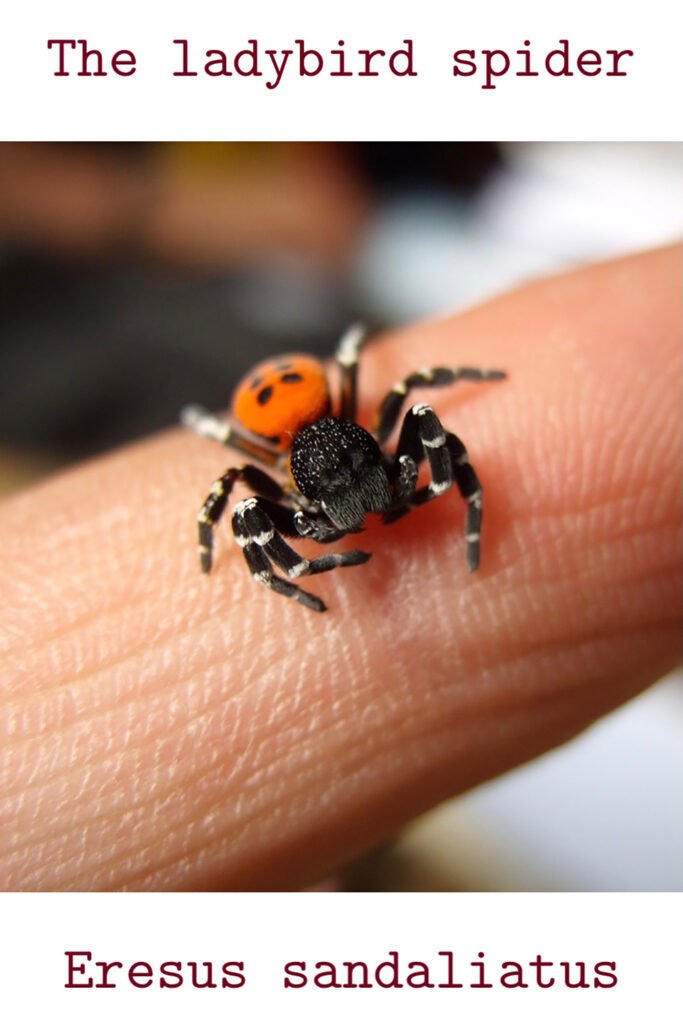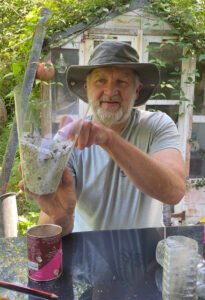Chocoholics and arachnophiles unite!
How hot chocolate may help save a spider. An update on the conservation of the ladybird spider project.
I’ve just realised that I haven’t given you a full run down on the Ladybird spider conservation project. I’ll get that written and to you in the next few days. You can take a look at their appearance on Spring watch here.
But for now let me tell you what we’re up to right now, creating containers, to use as translocation vessels. We use these vessels to house a few spiders who overwinter with us in Wales. They then head off onto a new site the following spring creating new populations and saving themselves from extinction.
Urine samplers and an Apollo spider programme
In the last couple of weeks our spider translocation method entered Mark VI (ish) with a very simple idea. We’ve moved from MKI wooden cold-frames, through MKII urine sample tubes. Then MKIII plastic water bottles with Apollo style separation methodology. To MKIV plaster (of Paris) and MKV wire frames that will dissolve into the heathland. “Whaaaaaaat?” You might say if you are new to all this. Well, it’s all academic now because those methods dissolved into history over a steaming mug of hot chocolate.
If you’re still reading, I’ll keep writing. The cold-frames were great but we had to walk away from them not knowing if the spiders had settled or what they would do. They often attached their webs to the walls of the frame making removal difficult and dodgy. They were cumbersome too. But, on the plus side, this was the first technique ever used anywhere, to successfully translocate ladybird spiders from one spot to another and it worked.
IT DOUBLED THE NUMBER OF POPULATIONS OF THIS ENDANGERED BRITISH SPECIES
from one, to a mighty Two!
Home-made cold-frames can save a species from extinction.

Spinning Silk in a wee tube –
I found that spiders we were moving would quite happily (or perhaps unhappily) build silk tubes in the containers they were transported in. These were urine sample tubes. So I worked with nature on this. Putting a paper sleeve filled with soil into the tube and the spiders into holes in the soil. This allowed us to plant spiders where we thought they should be for their own safety. I jumped for joy when we saw that they stayed where they had been put over winter. The trouble was that ladybird spiders feed using a surface web a bit like a tent and I had to damage the tent to feed the spiders and to perform the translocation.
It started with a meal deal but turned into an Apollo Mission for spiders in bottle gardens
I remember digging spiders in on the hot heathland and thinking that they needed something equally sealable but a bit larger. So they’re not in a flat or a caravan but have a mobile garden too. Taking a break in the shade and, sipping from my water bottle I tried to figure how this could be done cheaply. I don’t bother with meal deals now. But thank heavens (or the spider gods) that I did because the answer was in my hand.
I’d had no time to prepare my lunch so had picked up a meal-deal. Sandwich came with a bag of crisps and a drink and I had chosen (or the spider gods had guided me) to a bottle of water. It was perfect because it was ribbed. If I cut off the top I could use the ribs to clip it back on temporarily to prevent the spider escaping and I could do the same with the bottom to allow drainage once the unit was dug into the heath; just like an Apollo rocket. Well I thought so anyway. The bottle rocket separates off into three sections at critical times to ensure the arachnonauts survival and get them safely to their destination. I’m sure it is exactly how Blue Peter would, or will, get kids to the moon.
Anyway, it was near perfect but not quite all the way.

To Ian-finecky and beyond
Although it allowed 10 years of translocation and got us to the magic 10 populations, the bottle gardens were a little bit small for the largest spiders. Also we had non-biodegradeable tubes in the ground! These had to be removed at some point when we felt there wasn’t a spider in residence. I couldn’t think of anything I could buy (cheaply enough) that would address these problems. So we went beyond Blue Peter Methodology, yes, beyond it (?) to museum craft.
Beyond Apollo and even beyond Blue Peter
Using my old museum methods I sculpted a clay pot of just the right size in clay. I made a latex mould of clay original so I could make many copies. I chose a mixture of heathland soil caked together with plaster of Paris to make the pots. Thanks, yes, thanks to pollution, rainwater which falls now as dilute carbonic acid rather than water, dissolves plaster of Paris over a period of a few months so, in time our new pots would just disappear into the ground.
At the same time I tried cardboard wrapped in mesh which similarly dissolves away. The spider’s escapologist tendencies were combatted with sheets of clear acetate which, wrapped around the container, created an unclimbable wall that could be easily removed when the spiders were at their new home. The trouble with the new pots. Perfect for the job as they were. Is that they take quite a bit of time to make and they are heavier and bigger than the plastic bottles.

Proof that chocolate inspires innovation
About 4 weeks ago, I had just finished drilling drainage holes in about 60 pots and was keen to improve the design to avoid such monotony, when I sat down with Kerry and Ben for a hot chocolate; and there it was. Sitting on the table was the cardboard cylinder that contained the hot chocolate. Its thin walls allowed for a larger spider garden in a slightly smaller and lighter container. The smoothness of the walls allowed a single acetate sheet to be wrapped around and held in place with a rubber band rather than attaching sheets together. The tubs are not recyclable because they are made of a card and foil combination but they are biologically and chemically degradable so never need to be removed. And that’s our news!

It’s spider collecting season now and we’re still using the plaster pots at the moment. But we only have enough chocolate tubs for half of next year’s spiders. And here’s where you can help. Although we drink lots of hot chocolate here at Lifeforms HQ, I don’t think we’ll meet our quota of 60, especially during a heatwave.
So if you are avid drinkers of hot chocolate and you have some containers to spare, perhaps you could save them up and send them to us. We’ll reimburse your generosity with a free ladybird spider post card. Just head to our contact form and let us know you’re saving some for us and we’ll tell you where to send them.
Your chocolatey treat could help save a spider – thank you. The conservation of the ladybird spider continues.

